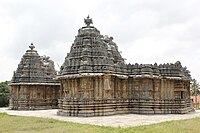
Back দ্বিতীয় বীর বল্লাল Bengali/Bangla Vîra Ballâla II French वीर बल्लाल २ Hindi Veera Ballala II Italian ವೀರ ಬಲ್ಲಾಳ 2 Kannada இரண்டாம் வீர வல்லாளன் Tamil రెండవ వీర భల్లాల Tegulu II. Veera Ballala Turkish Віра Балала II Ukrainian
| Veera Ballala II | |
|---|---|
| Hoysala King | |
| Reign | c. 1173 – c. 1220 CE |
| Predecessor | Narasimha I |
| Successor | Vira Narasimha II |
| Spouse | Cholamahadevi, Ketaladevi |
| Issue | Vira Narasimha II, Somaladevi |
| Dynasty | Hoysala |
| Hoysala Kings | ||||||||||||||||||||||||
|---|---|---|---|---|---|---|---|---|---|---|---|---|---|---|---|---|---|---|---|---|---|---|---|---|
|
||||||||||||||||||||||||






Veera Ballala II (Kannada: ವೀರ ಬಲ್ಲಾಳ 2) (r. 1173–1220 CE) was the most notable monarch of the Hoysala Empire. His successes against the Yadavas of Devagiri, the Southern Kalachuris, the Pandyas of Madurai and the waning Western Chalukya Empire, and his domination over the diminishing Cholas of Tanjore took the Hoysalas to their peak of power.[1][2][3][4] The historian Chaurasia claims by the end of the 12th century, Ballala II's conquests had made the Hoysalas the most powerful dynasty of the Deccan.[5] According to historian Derrett, Ballala II was "the most outstanding among Hoysala kings", and historian William Coelho in comparing Ballala II to King Vishnuvardhana writes, "he vied in glory with his grandfather".[6]
His court was adorned with some of the most notable of medieval Kannada language poets including the Jain poets Janna and Nemichandra, and the Brahman poet Rudrabhatta.[7][8] According to the historians Chopra et al., during his rule, the Hoysala kingdom consolidated into an independent empire commencing an age of "Hoysala imperialism".[9] His architectural legacy includes among numerous ornate temples, the Kedareshwara temple, the Veera Narayana temple and the Amrutesvara temple.[7] He was ably supported in war and in administrative matters by his son, prince Vira Narasimha II, and crowned queen Umadevi. His other queen Cholamahadevi was a Chola princes. His daughter Somaladevi was given in marriage to the Chola monarch Kulothunga Chola III.[7]
- ^ Kamath (1980), pp.126-127
- ^ Chopra, Ravindran and Subrahmanian (2003), part I, pp.154-155
- ^ Sastri (1955), p.193
- ^ Sen, Sailendra (2013). A Textbook of Medieval Indian History. Primus Books. pp. 58–60. ISBN 978-9-38060-734-4.
- ^ Radhey Shyam Chaurasia, p.248, History of Ancient India: Earliest Times to 1000 A. D., Atlantic Publishers (2002), New Delhi, ISBN 978-81-269-0027-5
- ^ Kamath (1980), p.126
- ^ a b c Kamath (1980), p.127
- ^ E.P. Rice (1921), p.43
- ^ Chopra, Ravindran and Subrahmanian (2003), part I, p.154